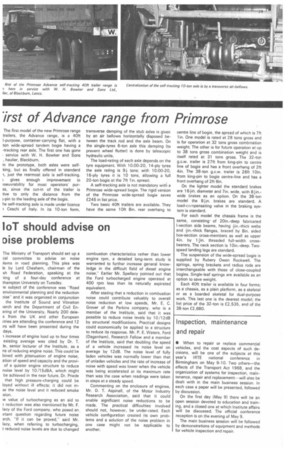loT should advise on Dise problems
Page 31

If you've noticed an error in this article please click here to report it so we can fix it.
The Ministry of Transport Should set up a :lel committee to advise on noise ilems in road planning. This plea was le by Lord Chesham, chairman of the sh Road Federation, speaking at the ling of a four-day conference at thampton University on Tuesday.
le subject of the conference was "Road environmental planning and the reduction aise" and it was organized in conjunction the Institute of Sound and Vibration ?arch and the Department of Civil Enering of the University. Nearly 200 dale s from the UK and other European itries are attending the conference and 12 ire will have been presented during the days.
increase of engine load up to four times existing average was cited by Dr. T. le, senior lecturer of the Institute, as a ns of reducing engine noise. This could be bined with pftenuation of engine noise, ation of speed and capacity and the proviof a quieter engine structure to reduce noise level by 10 /15dBA, which might be achieved in the near future. Dr. Priede that high pressure-charging could be loyed without ill effects; it did not inse the noise level and it reduced smoke is value of turbocharging as an aid to
reduction was also mentioned by Mr. F. lacy of the Ford company, who posed an irtant question regarding future noise 3rch. "If it can be proved," said Mr. lacy, when referring to turbocharging,
t reduced noise levels are due to changed combustion characteristics rather than lower engine rpm, a detailed long-term study is warranted to further increase general knowledge in the difficult field of diesel engine noise." Earlier Mr. Spellacy pointed out that the Ford turbocharged engine operated at 400 rpm less than its naturally aspirated equivalent.
After stating that a reduction in combustion noise could contribute valuably to overall noise reduction at low speeds, Mr. E. C. Grover of the Perkins company, who is a member of the Institute, said that it was possible to reduce noise levels by 10 /12dB by structural modifications. Practical designs could economically be applied to a structure to reduce its response. Mr. P. E. Waters, Ford (Dagenham), Research Fellow and a member of the Institute, said that doubling the speed of a vehicle increased its noise level on average by 12dB. The noise level of fully laden vehicles was normally lower than that of unladen vehicles and the rate of increase of noise with speed was lower when the vehicle was being accelerated at its maximum rate than was the case when readings were taken in steps at a steady speed.
Commenting on the enclosure of engines, Mr. D. T. Aspinall, of the Motor Industry Research Association, said that it could enable significant noise reductions to be made. The practical difficulties involved should not, however, be under-rated. Each vehicle configuration created its own problems and a solution of the noise problem in one case might not be applicable to another.










































































































